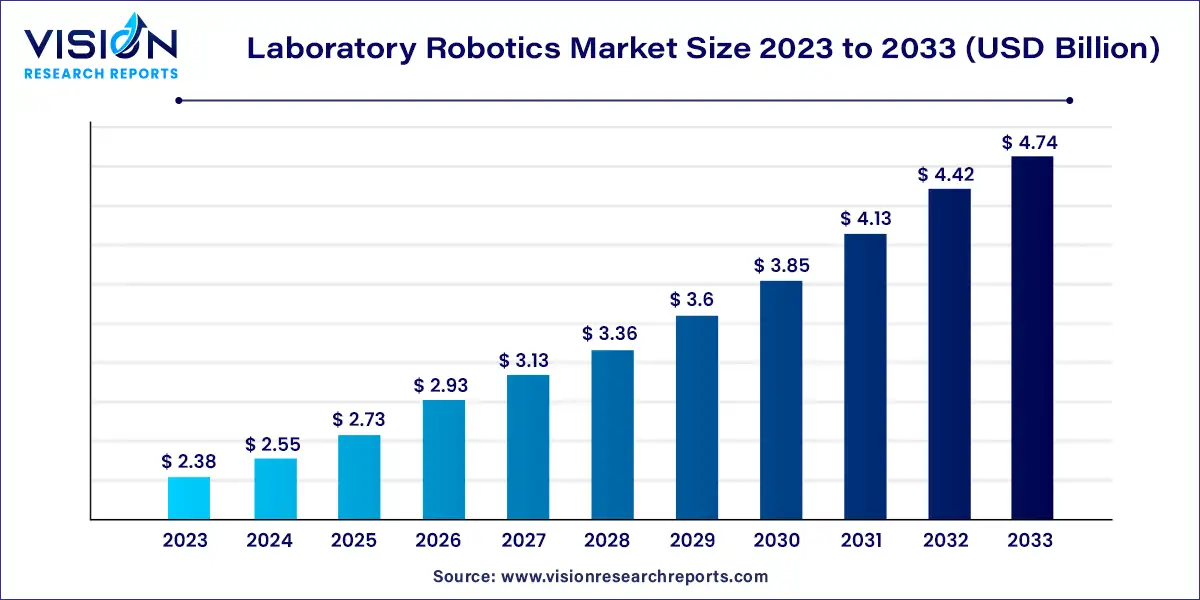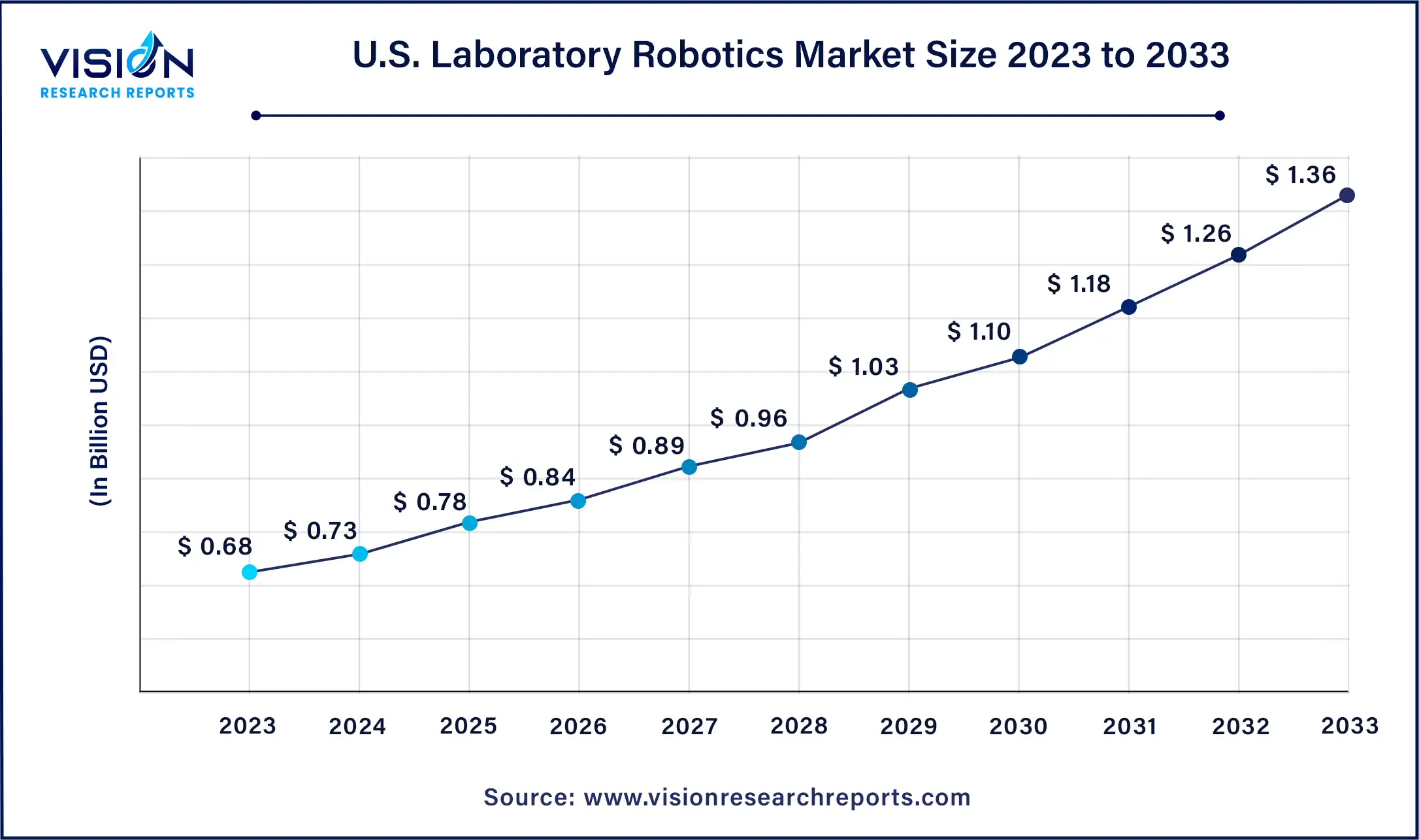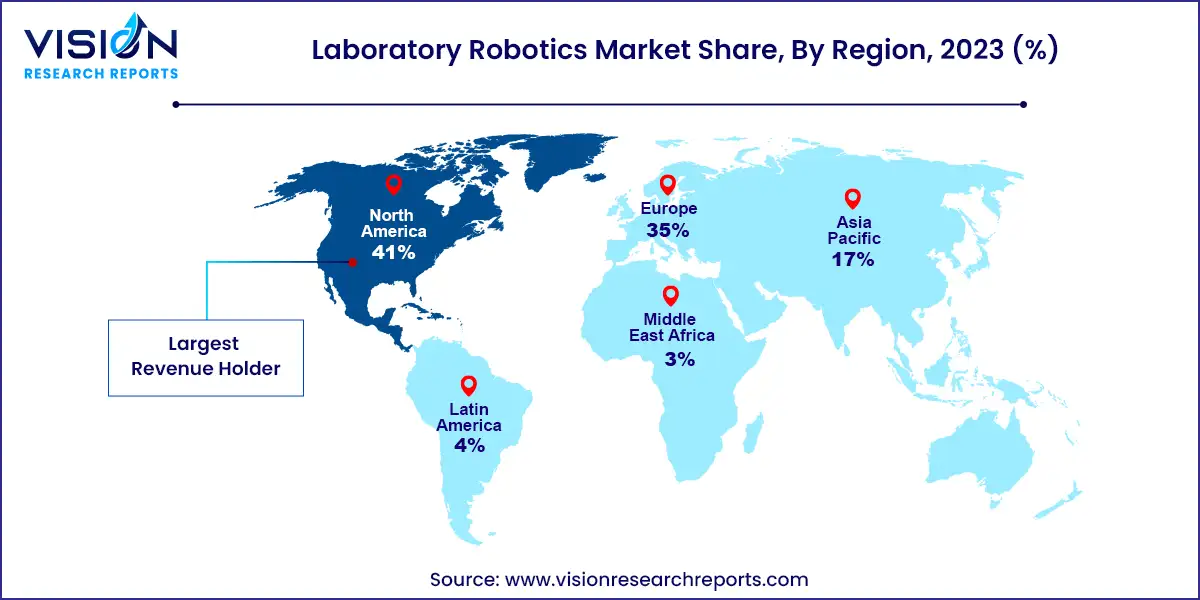The global laboratory robotics market size was estimated at around USD 2.38 billion in 2023 and it is projected to hit around USD 4.74 billion by 2033, growing at a CAGR of 7.13% from 2024 to 2033.

The laboratory robotics market is experiencing significant growth as technological advancements and increasing demand for automation drive innovation in laboratory processes. Laboratory robots are becoming indispensable in various sectors, including pharmaceuticals, biotechnology, clinical laboratories, and academic research institutions. These automated systems enhance precision, efficiency, and repeatability, leading to higher throughput and reduced human error.
The growth of the laboratory robotics market is propelled by the technological advancements, particularly in artificial intelligence and machine learning, are enhancing the capabilities and efficiency of robotic systems. These innovations enable more precise, reliable, and faster laboratory processes. Additionally, the increasing demand for automation across various industries, including pharmaceuticals, biotechnology, and clinical diagnostics, drives market expansion. Automation improves productivity, reduces human error, and lowers operational costs. Furthermore, the trend toward miniaturization and portability of robotic systems makes them more accessible and practical for laboratories with limited space. Collectively, these factors contribute to the robust growth of the laboratory robotics market.
The U.S. laboratory robotics market size was estimated at USD 0.68 billion in 2023 and it is expected to surpass around USD 1.36 billion by 2033, poised to grow at a CAGR of 7.17% from 2024 to 2033.

The U.S. laboratory robotics market held a significant share of the North American market in 2023, driven by a shortage of lab staff. Additionally, enhanced automation technologies are boosting efficiency and accuracy in laboratory processes.
The North American laboratory robotics market dominated the global market, accounting for a 41% revenue share in 2023, driven by technological advancements and increasing demand for automation in laboratories. Strategic partnerships between key players are further fueling this expansion. Collaborations between technology developers and research institutions enhance innovation, streamline workflows, and improve efficiency in laboratory processes.

The Asia-Pacific laboratory robotics market is experiencing substantial growth, fueled by increased funding and investment in innovative technologies. Key players in the region are receiving significant financial backing to develop advanced robotic solutions for laboratory automation. This investment is driving the adoption of cutting-edge robotics technology, enhancing efficiency, and expanding the market presence of laboratory robotics in various industries.
The lab automation workstations segment captured the largest market share of 38% in 2023. This growth is driven by the increasing demand for streamlined laboratory processes, which require higher throughput and efficiency. Additionally, advancements in robotics technology, such as improved precision and flexibility, are enhancing the capabilities of automated workstations, further propelling market growth. The rising adoption of lab automation solutions also contributes to the expanding market size. Furthermore, strategic initiatives by market players are accelerating growth. For example, in 2022, XtalPi, an AI technology company, acquired over 100 GoFa cobots to establish automated laboratory workstations at its testing center in China.
The automated plate handlers segment is expected to grow the fastest in the coming years, largely due to technological advancements. These advancements have led to the development of highly efficient and versatile plate handling systems capable of handling various types of plates with precision and speed. In February 2023, Automata introduced the LINQ platform, designed to fully automate workflows, including automated plate handlers and the movement of labware across all laboratory environments. The integration of advanced features such as robotic arms, vision systems, and sophisticated software has significantly improved the throughput and accuracy of plate handling operations. As laboratories increasingly seek to automate and streamline their processes, the demand for automated plate handlers continues to rise, further driving market growth.
The drug discovery segment held the largest share, 29%, of the market in 2023 due to several key factors. The increasing demand for innovative drugs to address various diseases drives extensive research and development efforts in pharmaceutical and biotechnology companies. For instance, in August 2021, Exscientia established a new 26,000 square foot robotic laboratory at Milton Park, Oxfordshire. The lab focuses on automating chemistry and biology processes to speed up drug discovery, enabling the company to develop drugs using AI and manufacture them using robots. Additionally, advancements in technology, such as artificial intelligence and machine learning, are revolutionizing drug discovery by enabling predictive modeling and virtual screening, further boosting the adoption of laboratory robotics.
The clinical diagnosis segment is projected to show significant growth during the forecast period. With an increasing emphasis on precision medicine and personalized healthcare, there is a growing demand for accurate and efficient diagnostic solutions. Laboratory robotics play a crucial role in automating various diagnostic processes, including sample handling, testing, and analysis, leading to faster turnaround times and improved accuracy. Furthermore, the rising prevalence of chronic diseases and the growing aging population are escalating the need for robust diagnostic capabilities. Chronic diseases such as diabetes, cancer, and cardiovascular conditions require ongoing monitoring and frequent diagnostic testing, thereby fostering market growth.
The clinical laboratory segment accounted for the largest market share of 56% in 2023, driven by advancements in clinical research and strong government support. Increased funding for healthcare infrastructure and research initiatives is propelling the adoption of laboratory robotic systems. These systems automate repetitive tasks, enhance precision, and improve workflow efficiency in clinical laboratories. For instance, in June 2023, United Robotics Group collaborated with Siemens and HUS Diagnostic Center to address the lab staff shortage crisis by unveiling umobileLAB. Developed in partnership with Siemens and HUS Diagnostic Center, uMobileLAB is designed to perform laboratory tasks. Additionally, the rising prevalence of chronic diseases and the demand for large-scale diagnostic testing underscore the need for advanced automation. This combination of clinical research advancements and government backing is accelerating the growth of laboratory robotics in clinical settings.
The research laboratory segment is expected to grow the fastest during the forecast period, driven by increased investments and technological advancements. Research laboratories are heavily investing in automation to enhance productivity, accuracy, and throughput of experimental processes. The adoption of laboratory robotics streamlines complex workflows, reduces human error, and accelerates data collection and analysis. For instance, in March 2024, Abbott launched its innovative GLP Systems Track automation solutions, designed to support laboratories' high-volume needs. This new offering aims to provide greater flexibility, enabling laboratories to optimize performance and efficiency to meet increasing demand. Furthermore, the rising demand for high-throughput screening and reproducibility in experiments is pushing laboratories to incorporate advanced robotic systems. These factors enhance the capabilities of research laboratories, driving innovation and enabling researchers to address complex scientific challenges with increased efficiency and effectiveness.
By Product
By Application
By End-use
By Region
 Cross-segment Market Size and Analysis for
Mentioned Segments
Cross-segment Market Size and Analysis for
Mentioned Segments
 Additional Company Profiles (Upto 5 With No Cost)
Additional Company Profiles (Upto 5 With No Cost)
 Additional Countries (Apart From Mentioned Countries)
Additional Countries (Apart From Mentioned Countries)
 Country/Region-specific Report
Country/Region-specific Report
 Go To Market Strategy
Go To Market Strategy
 Region Specific Market Dynamics
Region Specific Market Dynamics Region Level Market Share
Region Level Market Share Import Export Analysis
Import Export Analysis Production Analysis
Production Analysis Others
Others